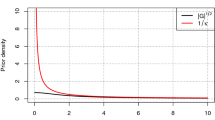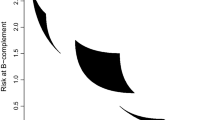Abstract
An observer is to make inference statements about a quantityp, called apropensity and bounded between 0 and 1, based on the observation thatp does or does not exceed a constantc. The propensityp may have an interpretation as a proportion, as a long-run relative frequency, or as a personal probability held by some subject. Applications in medicine, engineering, political science, and, most especially, human decision making are indicated. Bayes solutions for the observer are obtained based on prior distributions in the mixture of beta distribution family; these are then specialized to power-function prior distributions. Inference about logp and log odds is considered. Multiple-action problems are considered in which the focus of inference shifts to theprocess generating the propensitiesp, both in the case of a process parameterπ known to the subject and unknown. Empirical Bayes techniques are developed for observer inference aboutc whenπ is known to the subject. A Bayes rule, a minimax rule and a beta-minimax rule are constructed for the subject when he is uncertain aboutπ.
Similar content being viewed by others
Reference Notes
Duncan, G. T.Information and questionnaires in statistical inference (Tech. Rep. No. 140). Minneapolis, Minnesota: School of Statistics, University of Minnesota, 1970.
Good, I. J.The estimation of probabilities: An essay on modern Bayesian methods (Res. Monograph No. 30). Cambridge, Massachusetts: MIT Press, 1965.
Marschak, J. Remarks on the economics of information.Contributions to Scientific Research in Management. Los Angeles: Western Data Processing Center, UCLA, 1959, pp. 79–100.
References
Beach, L. R., Rose, R. M., Sayeki, Y., Wise, J. A., & Carter, W. B. Response proportions and verbal estimates.Journal of Experimental Psychology, 1970,86, 165–170.
Cox, D. R.,Analysis of Binary Data. London: Methuen & Co. Ltd., 1970.
de Finetti, B. Methods for discriminating levels of partial knowledge concerning a test item.The British Journal of Mathematical and Statistical Psychology, 1965,18, 87–123.
de Finetti, B.Probability, induction and statistics: The art of guessing. New York: John Wiley and Sons, Inc., 1972.
Ebel, R. L.Measuring educational achievement. Englewood Cliffs, New Jersey: Prentice-Hall, Inc., 1965.
Ferguson, T. S.Mathematical statistics, a decision theoretic approach. New York: Academic Press, 1967.
Good, I. J. Rational decisions.Journal of the Royal Statistical Society, Series B, 1952,14, 107–114.
Hampton, J. M., Moore, P. G., & Thomas, H. Subjective probability and its measurement.Journal of the Royal Statistical Society, Series A, 1973,136, 21–42.
Hendrickson, A. D. & Buehler, R. J. Proper scores for probability forecasters.Annals of Mathematical Statistics, 1971,42, 1916–1921.
Johnson, N. L. & Kotz, S.Distributions in statistics: Continuous univariate distributions—2. Boston: Houghton Mifflin Company, 1970.
Kroll, N. E. A. Learning of several simultaneous probability learning problems as a function of overall event probability and prior knowledge.Journal of Experimental Psychology, 1970,83, 200–215.
Laming, D. R. J.Information theory of choice-reaction times, New York: Academic Press, 1968.
McCarthy, J. Measures of the value of information.Proceedings of the National Academy of Science, 1956,42, 654–655.
Nicks, D. C., Prediction of two-choice decisions.Journal of Experimental Psychology, 1959,57, 105–114.
Rapoport, A. Mathematical methods in theories of international relations: expectations, caveats, and opportunities. In Zinnes, D. and Gillespie, J. (Eds.),Mathematical models in international relations New York: Praeger, 1976.
Roberts, H. V. Probabilistic prediction.Journal of the American Statistical Association, 1965,60, 50–62.
Savage, L. J. Elicitation of personal probabilities and expectations.Journal of the American Statistical Association, 1971,66, 783–801.
Shuford, E. H., Albert, A., & Massengill, H. E. Admissible probability measurement procedures.Psychometrika, 1966,31, 125–145.
Siegel, S. & Goldstein, D. Decision making behavior in a two-choice uncertain outcome situation.Journal of Experimental Psychology, 1959,57, 37–42.
Spragins, J. Learning without a teacher.IEEE Transactions on Information Theory, 1966,IT-12, 223–230.
Tversky, A. Assessing uncertainty.Journal of the Royal Statistical Society, Series B, 1974,36, 148–159.
Winkler, R. L. The quantification of judgment: Some methodological suggestions.Journal of the American Statistical Association, 1967,62, 1105–1120.
Winkler, R. L. & Murphy, A. H. Evaluation of subjective precipitation forecasts.Proceedings of the First National Conference on Statistical Meteorology, American Meteorological Society, 1968, 148–157.
Winkler, R. L. & Murphy, A. H. “Good” probability assessors.Journal of Applied Meteorology, 1968,7, 751–758.
Author information
Authors and Affiliations
Additional information
This research was partially supported by the Defense Advanced Research Projects Agency of the Department of Defense and was monitored by ONR under Contract No. N00014-77-C-0095. Any opinions, findings, conclusions or recommendations expressed herein are those of the author and do not necessarily reflect the views of the Defense Advanced Research Projects Agency, the Office of Naval Research, or Carnegie-Mellon University.
Rights and permissions
About this article
Cite this article
Duncan, G.T. Binary action based estimation of propensities. Psychometrika 43, 93–107 (1978). https://doi.org/10.1007/BF02294092
Received:
Revised:
Issue Date:
DOI: https://doi.org/10.1007/BF02294092




